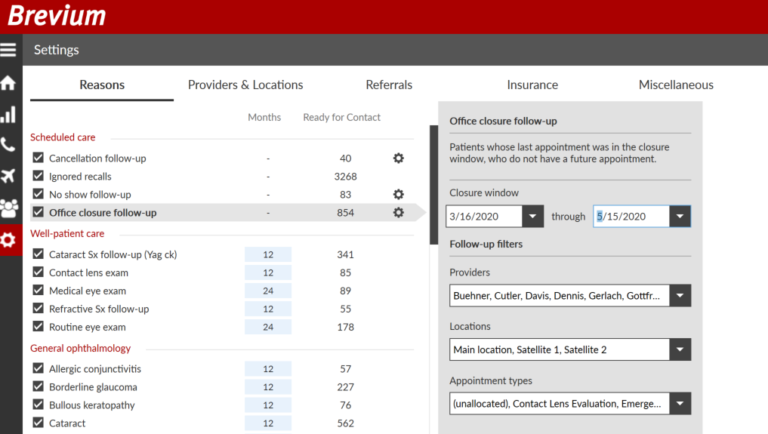The Brevium Blog

How To Increase Collections and Appointments with Proven Patient Reactivation Processes
Providing a valuable return on investment (ROI) is one of the most pressing challenges facing private equity groups. When investing in dental practices or expanding a management organization, private equity groups stake every deal on a newly acquired practice meeting profitability targets, with expected annual returns as high as 20%. That means finding the best ways to increase ROI in these practices. That’s exactly what you can do by increasing collections and appointments. Let’s start from the beginning, though.
Understanding Hurdles and Due Diligence
Due diligence means understanding the hurdles a practice faces on the path to profitability so you can invest capital where it makes a difference. All these hurdles contribute to a practice’s productivity and revenue. When it comes to the factors that affect your ultimate ROI, no item — from a dated practice management system to an inefficient schedule — is too small to consider in an investment decision.
Hurdles Demand a Proactive Approach
Though every practice has unique variables, they also have similar struggles as businesses. When evaluating practices, you can’t ignore the pervasive, negative trend of overdue patients. In fact, on average, 25% of patients at any given practice don’t go to follow-ups or respond to recall efforts, forming a sizable pool of inactivity. This means that they are missing important care and you are losing revenue. Fortunately, you can fix this, though, with a comprehensive reactivation strategy and a capable tool to execute it. Let’s explore more how patient reactivation is critical to smart healthcare investments and how, with the right tool, you can optimize your practice’s efficiency.
The Problem of Attrition
Every medical practice struggles with varying degrees of patient attrition. Some reasons for attrition — such as limited availability and patients moving away or simply not needing re-care — are outside of your immediate control. However, you can address other causes.
Some of the most common include:
- Ineffective recall practices
- Relying on only one recall method
- Data loss
- New practice management systems
Because most practices don’t have a reactivation strategy in place — overdue patients are often written off as a lost cause. To replace lost revenue and keep schedules full, practices acquire new patients which ends up costing them more.
The True Value of Reactivation
It’s a fairly commonly held fact in business that retaining clients is much less expensive than acquiring new ones. In addition, when calculating long-term ROI, think not just of revenue per visit or even per period of fully booked scheduling but also of the potential lifetime revenue a returning patient generates: the total value a patient will bring to your practice over the entire life of your relationship with them. Also keep in mind that every new patient begins with a lead, which, according to health industry experts can cost from $26 to $125.4 per person. The costs continue with the efforts required to convert leads into dedicated patients. To better calculate the ROI of new patient acquisition, you need to subtract fixed expenses from projected lifetime revenue.
Reactivation of overdue patients, on the other hand, represents additional revenue after fixed acquisition costs have already been covered — they represent the most profit with the least expense. Ultimately, it’s five to 25 times easier to generate revenue from existing patients than it is to acquire new ones. If reactivation is clearly more valuable than acquisition, why do most practices prioritize the latter? The answer is that many practices and practice groups lack the resources and specialized tools.
What to Look for in a Patient Reactivation System
When you’re shopping for a patient retention software solution that includes a patient reactivation system, you’ll need a software solution that is:
- Purpose-built.
- HIPAA-compliant
- Data-driven
- That interfaces with PMSs (to improve patient care and fill schedules with high-priority patients)
- One that finds patients who have stopped responding
- Data migration assistance
- ROI tracking
- More than one patient outreach option
- Ways to automate outreach
A system that includes all of these tools will help you improve patient engagement and find ways to connect with patients. These are all key factors to consider when shopping for a patient reactivation system that will actually get your results.
Solving Data Migration Woes
Let’s look at an example of a company that had data migration woes solved by a software solution. As an expanding organization, Elevate’s PMS struggles echoed those of many private equity-backed groups we’ve talked about. The truth is, when one practice acquires another, the old and new databases seldom align, leading to data loss — including lost diagnoses and visit history, among other things — another leading cause of patient attrition.
Elevate encountered this problem with one of its partner practices, Women’s Health Group (WHG). WHG used an electronic health records (EHR) system incompatible with Elevate’s, and as a result, Elevate was unable to see which patients needed appointments in the new system. Fortunately, Elevate used a software solution that helped them link the two systems together. Elevate was able to maintain a working stitch between WHG’s old EHR and a new athenahealth EHR.
Data Is Power
An effective solution should also offer data that you can use to evaluate your options. It’s much easier to schedule and reactivate by a selected metric (e.g., create a report showing all overdue patients with a particular diagnosis) and to any specific doctor or location. One way that Elevate used this was to focus its reactivation efforts on women overdue for annual exams. You could also do this with things like Terminology (CPT®) codes to identify patients eligible for certain surgeries. A system that offers easy-to-use reporting and data will help you better able to identify which patients need care and how to schedule those patients in a way that drives growth, productivity, and revenue.
The ROI Is in the Numbers
For private equity groups acquiring healthcare assets, all investment decisions return to one central question: What capital improvements will drive a practice’s growth, productivity, and revenue — and ultimately provide valuable ROI? Thankfully, the profit figures of patient reactivation make that decision easy.
In 2019, a study of 102 American ophthalmology practices (ALOHA study) sought to measure the effectiveness of various patient reactivation methods. Reactivated patients were found to generate $457.86 total median revenue over a 12-month period following their reactivation. Not only is this revenue free of fixed fees, but it also indicates that reactivated patients return for follow-ups and subsequent procedures once reactivated. Recalled patients generate an average of 2.2 visits, with 62% of revenue collected in the 12 months following the initial appointment.
Invest Capital Where It’s Proven to Provide a Return
Overdue patients are a reality at every practice and most practices have thousands. Even when practices recognize the issue, they’re often unable to create actionable ways to re-engage lost patients. These patients represent a significant pool of revenue. However, the gap between patient inactivity and profit is bridged with the right patient reactivation strategy and a capable tool to execute it. That’s why you should invest in Brevium as your patient reactivation software solution of choice.
Each of its features is proven through studies, statistics, and customer experience to improve care, streamline management and increase revenue. Capital should be invested where ROI potential is highest. For patient reactivation, Brevium makes that an easy decision.














